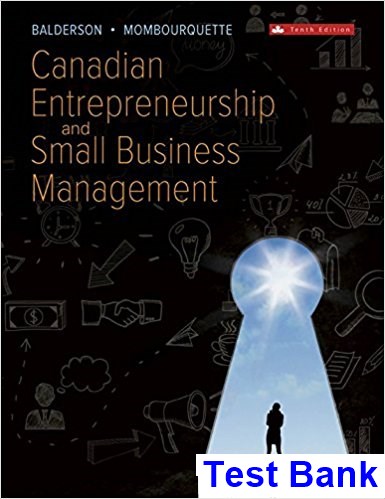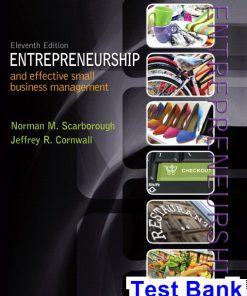Canadian Entrepreneurship and Small Business Management Canadian 10th Edition Balderson Test Bank
$26.50$50.00 (-47%)
Canadian Entrepreneurship and Small Business Management Canadian 10th Edition Balderson Test Bank.
You may also like
Canadian Entrepreneurship and Small Business Management Canadian 10th Edition Balderson Test Bank

Product details:
- ISBN-10 : 1259102688
- ISBN-13 : 978-1259102684
- Author: Peter S. Mombourquette
Balderson is recognized as a market leading text that offers strong coverage of the theory of entrepreneurship and small business management, blended seamlessly with practical Canadian examples of actual entrepreneur experiences (Small Business Profiles). Focus is on currency and emerging trends, generating and maintain student interest through cases and thought-provoking questions, and improving academic rigour, while staying true to the book’s vision of being easy to follow and absorb.The numerous individual cases, as well as a comprehensive running case, are continuing strengths of this text, as is the fact that it is indigenously Canadian and supports learning in a Canadian business context through its content.
Table contents:
- Part 1: The Decision to Start a Business
- Chapter 1: The Role of Entrepreneurship and Small Business in Canada
- Learning Objectives
- Small Business Profile
- Introduction to Entrepreneurship and Why Students Will Want to Study the Subject
- Nature and Development of Entrepreneurship in Canada
- Increases in the Number of Business Establishments
- Increases in the Number of Employees of Small Businesses
- Increases in Government Interest and Programs
- Increases in the Number of Small Business–Related Courses at Colleges and Universities
- Increases in Entrepreneurial Activities Known as Intrapreneurship in Large Businesses
- Increases in the Political Power of Small Business
- Improvement in the Image of Small Business
- What Is Small Business?
- Comparison and Evaluation
- Government Programs
- Lending Programs
- Current State of Small Business in Canada
- Young Entrepreneurs
- Senior Entrepreneurs
- Female Entrepreneurs
- Immigrant Entrepreneurs
- Entrepreneurial Activity by Industry
- Entrepreneurial Activity by Region
- Contributions of Small Business
- Labour Intensity
- Innovations and Inventions
- Productivity and Profitability
- Flexibility
- Canadian Ownership
- Small Business Health as a Link to Economic Growth
- Social Contributions
- Small Business and the Future
- Technology
- The Internet and Mobile Technology
- Consumer Demographics
- Competitive Aspects of Markets
- The Economy
- The Political Climate
- The Social Climate
- Learning Objectives Summary
- Time to Take Action
- Discussion Questions
- Experiential Exercises
- Chapter 2: The Small Business Decision
- Learning Objectives
- Small Business Profile
- The Small Business Decision: Personal Evaluation
- Advantages of Small Business Ownership
- Disadvantages of Small Business Ownership
- Demographic Characteristics of Entrepreneurs
- Personality Characteristics Required by Successful Entrepreneurs
- The Small Business Decision: Organizational Evaluation
- Small Business Successes
- Small Business Failures
- Entrepreneurship and Small Business Management
- Entrepreneurial Skills
- Managerial Skills
- Entrepreneurial Success in Large Businesses
- Learning Objectives Summary
- Time to Take Action
- Discussion Questions
- Experiential Exercises
- Appendix 2A: Entrepreneur Suitability Checklists and Tests
- Chapter 3: Evaluation of a Business Opportunity
- Learning Objectives
- Small Business Profile
- Entrepreneurial Process
- Ideas
- Sources of New Ideas
- Assessment of Business Opportunities
- Qualitative Assessment
- Goals
- Content of Work
- Lifestyle
- Capabilities
- Experience
- Opportunity Assessment
- Evaluating How to Break Into the Market
- Developing a Strategic Competitive Advantage
- The Right Industry
- The Right Business
- The Right Aspect of the Business
- Collecting Information
- Sources of Information
- Quantitative Assessment of Business Opportunities
- Preparing the Feasibility Analysis
- Step 1: Calculate Market Potential
- Step 2: Calculate Market Share
- Step 3: Calculate Net Income and Cash Flow
- Learning Objectives Summary
- Time to Take Action
- Discussion Questions
- Experiential Exercises
- Comprehensive Case—Dan Kim: Part 1
- Cases for Part 1
- Petite Shop (A)
- Petite Shop (B)
- Big D’s Painting Company
- April’s Micro-Business Mobile Marketing Company
- Appendix 3A: Small Business Reference Books and Sources of Information
- Part 2: Preparing for Small Business Ownership
- Chapter 4: Organizing a Business—The Business Plan
- Learning Objectives
- Small Business Profile
- Getting Started: Establishing the Business
- Advantages of Organizing a Small Business from Scratch
- Disadvantages of Organizing a Small Business from Scratch
- The Small Business Plan
- Writing the Plan
- Components of the Plan
- Prepare a Table of Contents
- Prepare a Synopsis of the Plan in an Executive Summary and Background Statement
- Describe the Management Team
- Establish Business Objectives
- Plan the Marketing Approach
- Describe the Selection of the Location
- Determine the Physical Facilities
- Plan the Financing
- Plan the Personnel
- Investigate the Legal Requirements
- Assess the Risk
- Using and Implementing the Business Plan
- Measuring Plan Progress
- Updating the Plan
- Learning Objectives Summary
- Time to Take Action
- Discussion Questions
- Experiential Exercises
- Appendix 4A: Checklist for a Small Business Plan
- Appendix 4B: Sample Business Plans
- Business Plan 1—Retail Stocking Store, The Sock Hop
- Business Plan 2—Quality Cuts
- Chapter 5: Buying a Business and Franchising
- Learning Objectives
- Small Business Profile
- Purchasing an Existing Business
- Advantages of Purchasing
- Disadvantages of Purchasing
- Sources of Businesses for Sale
- Internet
- Government Departments
- Trade Journals
- Real Estate Brokers
- Other Professionals
- Word of Mouth
- Evaluating a Business for Sale
- Industry Analysis
- The Previous Owner
- Financial Condition of the Business
- Condition of the Assets
- Quality of Personnel
- External Relationships—Suppliers and Customers
- Condition of the Records
- Determining the Price or Value of a Business
- Market Value
- Asset Value
- Earnings Value
- Combination Methods
- The Purchase Transaction
- Negotiating the Deal
- History and Background of Franchising
- What Is Franchising?
- Manufacturer-Directed Franchise
- Wholesaler-Retailer–Directed Franchise
- Franchising Company
- Advantages of Franchising
- Proven Market for the Product or Service
- Services the Franchisor May Provide
- Potential Disadvantages of Franchising
- Lack of Independence
- Cost of the Franchise
- Unfulfilled Promises
- Restrictions on the Contract
- Saturation of the Market
- Lack of Security
- Cost of Merchandise
- Effectiveness of Promotions
- Exaggeration of Financial Success
- Difficulty in Settling Disputes
- Finding a Franchise
- Evaluation of a Franchise Opportunity
- 1. Unproven versus Proven Franchise
- 2. Financial Stability of Franchise
- 3. Potential Market for the New Franchise
- 4. Profit Potential for a New Franchise
- 5. Territorial Protection
- 6. Training and Operations Assistance
- 7. Contract Length and Renewal, and Termination Terms
- 8. What Current Owners Say about Their Franchise
- The Entrepreneur as Franchisor
- What Businesses Can Be Franchised?
- How Does Someone Become a Franchisor?
- Franchising in the Future
- Learning Objectives Summary
- Time to Take Action
- Discussion Questions
- Experiential Exercises
- Comprehensive Case—Dan Kim: Part 2
- Appendix 5A: Checklist of Considerations in Purchasing a Business
- Appendix 5B: A Checklist for the Potential Franchisee: Questions to Answer Affirmatively Before Goin
- Chapter 6: Financing the Small Business
- Learning Objectives
- Small Business Profile
- Small Business Financing
- The Importance of Capital and Planning
- Determining the Amount of Funds Needed
- Start-Up Costs
- Ongoing Operating Costs
- The Owner’s Net Worth
- Determining Types of Financing
- Business Stages and Financing
- Equity Financing
- Bootstrap Financing
- Debt Financing
- Determining the Term of Financing
- Preparing a Proposal to Obtain Financing
- 1. The Applicant’s Management Ability
- 2. The Proposal
- 3. The Applicant’s Background and Creditworthiness
- Lender Relations
- Learning Objectives Summary
- Time to Take Action
- Discussion Questions
- Experiential Exercises
- Comprehensive Case—Dan Kim: Part 3
- Cases for Part 2
- Clark’s Sporting Goods
- Jensen Roofing
- Conrad’s Photographer’s Supplies
- Kelly’s Grill
- Second Cup
- Appendix 6A: Provincial Equity Capital Programs
- Appendix 6B: Federal Government Assistance Programs for Small Business
- Part 3: Managing the Small Business
- Chapter 7: Marketing Management
- Learning Objectives
- Small Business Profile
- The Role of Marketing Management in the Small Business
- The Marketing Plan
- Characteristics of a Marketing Plan
- The Marketing System: Influences on the Small Business
- The Marketing Mix
- Steps in Preparing the Marketing Plan
- Defining the Business Situation
- Market Segmentation and Target Marketing: Beyond the Basics
- Customer Profile
- Considering Strengths and Weaknesses
- Customer Relationship Marketing
- Establishing Goals and Objectives
- Defining Marketing Strategy and Action Programs
- Budgeting the Marketing Strategy
- Monitoring Progress of Marketing Actions
- Contingency Planning
- Why Some Plans Fail
- Learning Objectives Summary
- Time to Take Action
- Discussion Questions
- Experiential Exercises
- Chapter 8: Managing the Marketing Mix
- Learning Objectives
- Small Business Profile
- The Role of the Marketing Mix in Small Business
- Developing the Product or Service
- Develop Product or Service Policies
- Decide How the Product will be Manufactured
- Understand the Product Life Cycle
- Determine Factors That May Accelerate Product or Service Adoption
- Understand How the Consumer Classifies the Product or Service
- Understand How Businesses Classify the Product or Service
- Developing the Distribution System
- Channel Options
- Channel Length
- Channel Intensity
- Social Selling/Multi-Level Marketing
- Setting the Price for the Good or Service
- Cost-Based Pricing
- Demand-Based Pricing
- Competition-Based Pricing
- Value-Based Pricing
- Promotion
- Steps in a Promotional Campaign
- Types of Promotion
- Learning Objectives Summary
- Time to Take Action
- Discussion Questions
- Experiential Exercises
- Chapter 9: Financial Management
- Learning Objectives
- Small Business Profile
- The Need for Financial Records
- The Accounting Cycle
- Recording Transactions
- Classifying Transaction Totals
- Summarizing Data
- Accounting Systems for the Small Business
- Manual Systems
- Outsourcing Financial Activities
- Small Business Computer Systems
- Management of Financial Information for Planning
- Short-Term Financial Planning
- Long-Term Financial Planning
- Evaluation of Financial Performance
- Management of Current Financial Position
- Evaluation of Financial Statements
- Credit and the Small Business
- Advantages of Credit Use
- Disadvantages of Credit Use
- Management of a Credit Program
- Use of Bank Debit and Credit Cards
- Learning Objectives Summary
- Time to Take Action
- Discussion Questions
- Experiential Exercises
- Comprehensive Case—Dan Kim: Part 4
- Appendix 9A: Use of Financial Ratios for a Small Business (Automotive Dealer)
- Chapter 10: Operations Management
- Learning Objectives
- Small Business Profile
- Management of Internal Operations
- The Production Process
- Total Quality Management
- Physical Facilities
- Layouts
- Layouts for Manufacturing Firms
- Layouts for Retail Firms
- Layouts for Service Firms
- Purchasing and Controlling Inventories
- Sources of Supply
- Evaluating Suppliers
- Determining Order Quantities
- Inventory Control
- The Small Business–Supplier Relationship
- Supply Chain Management
- Learning Objectives Summary
- Time to Take Action
- Discussion Questions
- Experiential Exercises
- Comprehensive Case—Dan Kim: Part 5
- Chapter 11: Human Resources Management
- Learning Objectives
- Small Business Profile
- Human Resources Management and the Small Business
- Planning for Human Resources
- The Hiring Process
- Sources of Employees
- The Screening Process
- Candidate Selection and Notification of the Hiring Selection
- Personnel Management
- The Introduction Period
- The Probationary Period
- Training
- The Owner-Manager as Leader and Personnel Manager
- Organization Culture
- Motivation, Engagement, and Loyalty
- Paying Employees
- Fringe Benefits
- Controlling and Evaluating Employee Performance
- Handling Grievances
- Terminating the Employee
- Unionization and the Small Business
- Government Requirements and Assistance
- Federal Government
- Provincial and Territorial Governments
- Municipal Governments
- Record Keeping for Employers
- Employee Remittance Number
- Payroll Book
- Contract Employees
- Learning Objectives Summary
- Time to Take Action
- Discussion Questions
- Experiential Exercises
- Comprehensive Case—Dan Kim: Part 6
- Chapter 12: Management Help: Mentors, Boards of Advisors or Directors, and Tax Assistance
- Learning Objectives
- Small Business Profile
- Advisors and Small Business
- Use of Advisors
- Taxation and Small Business
- General Tax Management Principles
- Continual Tax Planning
- Tax Deferral
- Income Splitting
- Marginal Tax Rates
- Deductibles
- Government Tax-Related Programs
- The Incorporation Question
- The Remuneration Question
- Transferring the Business: Capital Gains
- Goods and Services Tax (Gst) or Provincial Sales Taxes (Pst) and Hst
- Learning Objectives Summary
- Time to Take Action
- Discussion Questions
- Experiential Exercises
- Cases for Part 3
- Derocher’s Market
- Home Smart Hardware Store
- Martha’s Designs
- Sadie’s Country n’ Western Store
- Dale’s Sport Pursuit
- Susie’s Fashions
- Taylor Construction Company
- The Barrow Bracket
- Threadz
- Garner Men’s Wear
- Boomerang Bouncers Entertainment
- Part 4: Looking to the Future
- Chapter 13: Managing Growth
- Learning Objectives
- Small Business Profile
- Small Business and Growth
- The Business Cycle
- Introduction
- Growth
- Maturity
- Decline
- Problems Created by Growth
- Owner-Manager Fatigue and Stress
- Lack of Communication
- Human Resources Problems
- Lack of Coordination
- Shortage of Cash
- Low Profitability
- Breakdowns in Production Efficiency
- Lack of Information
- Owner Lifestyle
- Evaluating the Growth Question
- Is the Business One That Can Grow?
- Is the Business Owner Prepared to Make the Effort?
- Does the Owner-Manager Have the Capabilities to Grow?
- How Should the Owner-Manager Pursue Growth?
- Planning for Growth
- The Expansion Plan
- Understanding the Requirements of Growth
- Learning Objectives Summary
- Time to Take Action
- Discussion Questions
- Experiential Exercises
- Comprehensive Case—Dan Kim: Part 7
- Chapter 14: Managing the Transfer of the Business
- Learning Objectives
- Small Business Profile
- Long-Range Planning
- Alternatives for the Business
- Succession Planning
- Transferring Ownership to Family Members
- Selling the Business to an Employee
- Selling the Business to Outsiders
- Going Public
- Closing Down Or Going Bankrupt
- Learning Objectives Summary
- Time to Take Action
- Discussion Questions
- Experiential Exercises
- Cases for Part 4
- Bailey’s Office Supply
- Baker Hardware Ltd.
- Brian Luborsky—Premier Salons International Inc.
- Company’s Coming Cookbooks
- Directory of Supplementary Cases
- Thomson Greenhouse
- Robinson Test Prep Co.
- Beach Buddy
- Organic Gourmet Express
- The Winslow Clock Company
- Window Tech Inc.
- Edge Hockey
- Beach Stake
- The Framemakers
- Top Human Technology Limited
- Clovis Jewellers
- Blake Lock and Security Systems
- Endnotes
- Chapter Sources
- Index
People also search:
canadian entrepreneurship and small business management 11th edition
canadian entrepreneurship and small business management 11th edition pdf
canadian entrepreneurship and small business management
canadian entrepreneurship and small business management pdf free












